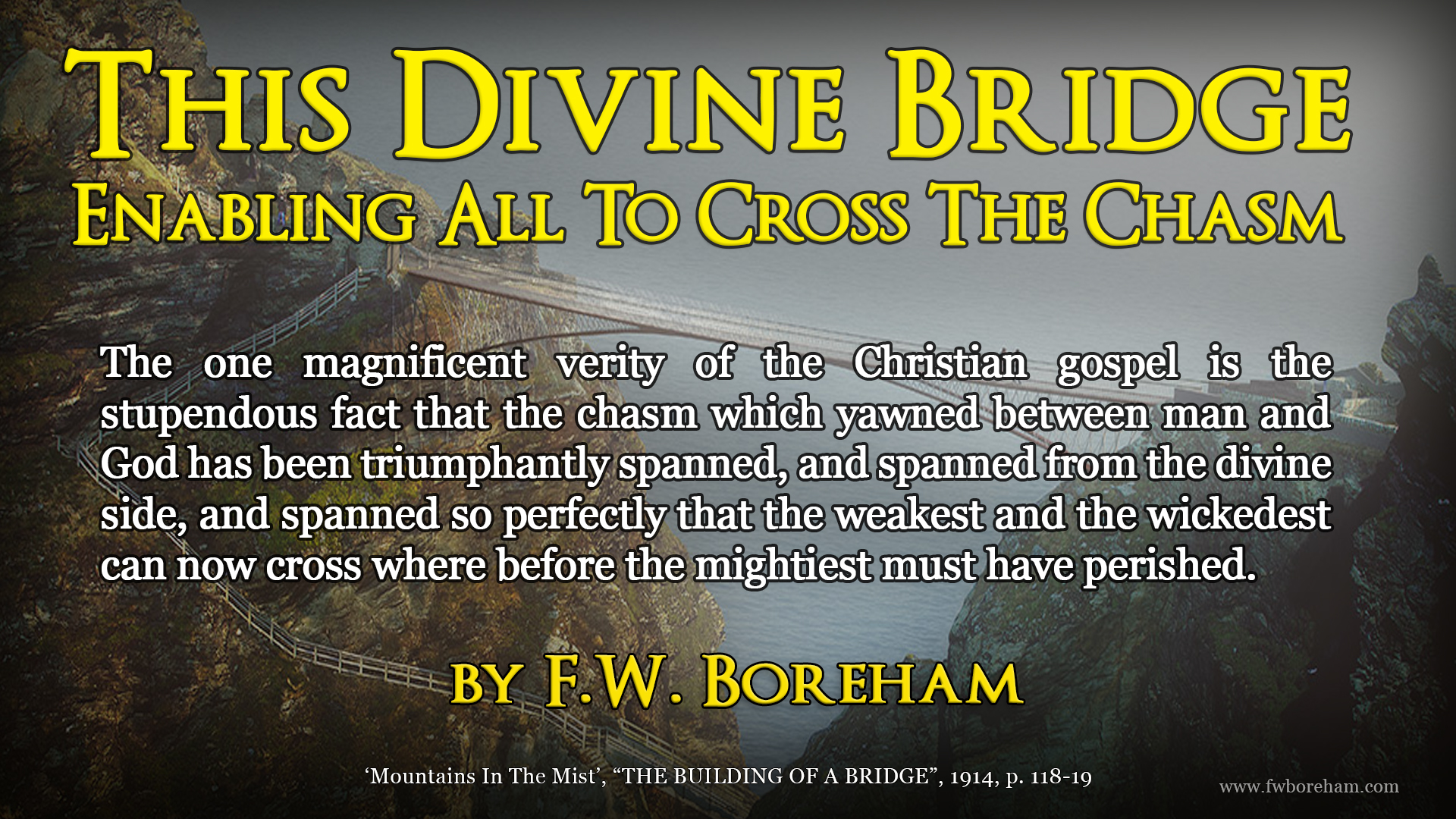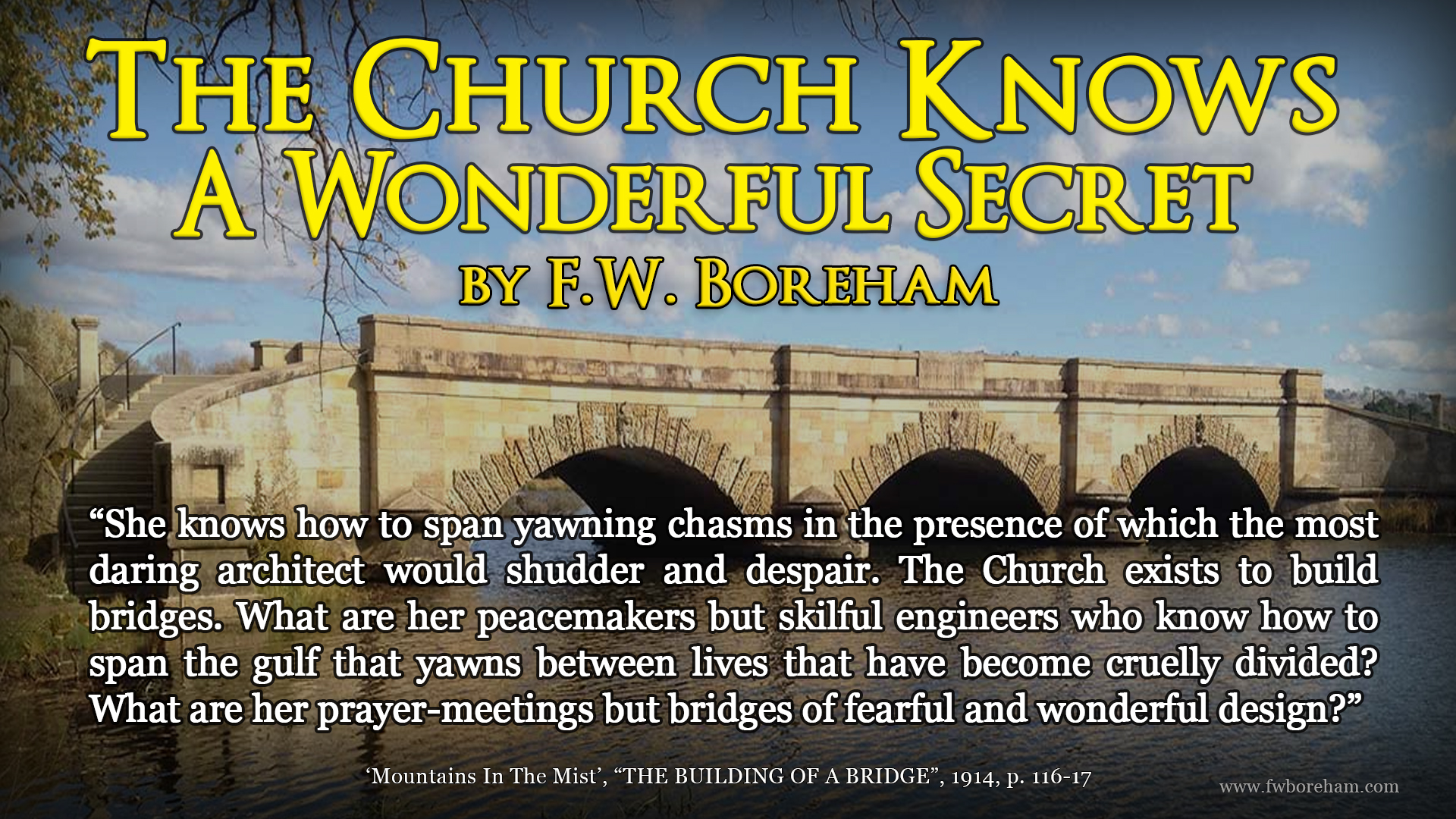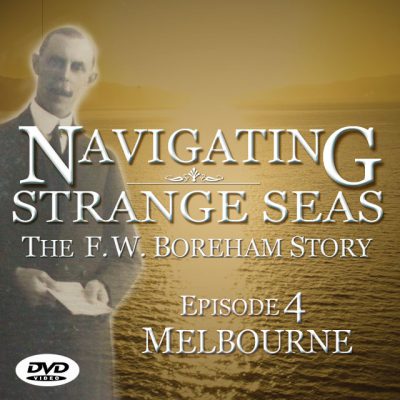home > books by FWB > 1914 Mountains in the Midst > Section 2, Chapter 2, THE BUILDING OF THE BRIDGE
II
THE BUILDING OF THE BRIDGE
My paper this morning contains a cablegram from England announcing the death of Sir William Arrol, the peerless prince of bridge-builders. And, since reading the tale of his audacious undertakings and bewildering achievements, it has dawned upon me that bridge-building is the only profession worth following! It is a lovely thing to see life’s deep ravines— its raging torrents, its yawning abysses, its perilous chasms — and to fling across them bridges by which a little child may cross in safety. When I come to think of it, it really seems to me that we are sent into this old world of ours for no other purpose than to build bridges. Deep down in the mystery of our complex and wonderful nature there is a passionate yearning to span life’s chasms. The instincts of the bridge-builder surge in our very veins, and sooner or later, in some form or other, they will certainly betray themselves.
Now, a chasm is always a tantalizing affair. Even when we were children, playing, on those long and lazy summer Satin days, beside the babbling trout stream, as it meandered through the meadows, how wistfully we gazed at the willows, the hazels, and the blackberries on the opposite bank! As a matter of fact, there was nothing on that side that did not grow just as profusely on our own. But there it was! And as we fished and frolicked on our side of the flashing stream, the opposite bank teased our fancy and tortured our imagination. The very laughter of the rippling waters seemed to mock our inability to cross. And then, on one unforgettable holiday, there came a crowded hour of glorious life in which, at the hazard of our lives, we actually crossed the taunting waters. And who shall describe the rapture that flushed our faces, and ran down through all our blood, when we found ourselves romping among the buttercups, the daffodils, and the cowslips on that other bank? How every nerve tingled with triumph! The landing of Columbus on American soil was not effected amidst wilder transports of delight than were ours at that tremendous moment. With what proud and rapturous disdain we looked back upon the familiar common-places on our own side of the stream ! What did it all mean ? It simply meant that we had tasted, perhaps for the very first time, the joy of the bridge- builder.
And, after all, Columbus had done no more. We have all followed Prescott’s thrilling story of the young Italian’s anguish as he gazed across the wild Atlantic waters at the world of which he had dreamed, but saw no way of reaching it. It was precisely the same poignant emotion, on a slightly larger scale, which we schoolboys experienced as we looked across the English trout-stream. And what was that adventurous and epoch-making voyage across uncharted seas, with black tempest roaring around and blacker mutiny raging aboard, but the construction of a bridge between the eastern and western hemispheres? Bancroft opens his immense History of the United States with this sentence: ‘The enterprise of Columbus — the most memorable maritime enterprise in the history of the world — formed between Europe and America the communication which will never cease.’ That is to say, he built a bridge, and built it well. And what was Captain Cook but the builder of a bridge between the northern and southern hemispheres? By means of those thrilling and romantic voyages he spanned the terrific chasm that yawned for countless centuries between the old world on the one bank and all the continents and islands of these southern seas on the other. Columbus and Cook were bridge-builders. That is all.
That is always the case. The explorer, whether on sea or land, whether at the Pole or the Equator, is a master-builder of bridges. And we applaud him so enthusiastically because he appeals so directly to that subtle longing that in boyhood made us yearn for the other side of the sparkling stream. We love to be linked up. We like to feel that we are in touch with everything. A child glories in pictures of red men, and yellow men, and olive men, and bronze men, and brown men, and black men; and he loves to feel that there are ships and trains by which these strange people can be reached. He collects postage stamps simply because they bring him into touch with all the remotest cracks and corners of civilization. He throws up his cap to welcome the swallows in the springtime because they have seen such strange things since he saw them in the autumn. They link him up with the people of some semi-tropical clime among whom they last made their homes. And, if I cared to labour the point, I could easily show that all our modern inventions — our telephones and telegrams, our mammoth liners and flying expresses, our Marconigrams and aeroplanes — are simply bridges, all of them, and we appreciate them so highly because they span our chasms so effectively. And what is language itself but the cunning contrivance by which we bridge the gulf that would otherwise yawn between one human soul and another? For there are chasms much more difficult to span than those represented by yards and furlongs and miles. What about those that are represented by months and years and centuries? How would the genius of Sir William Arrol grapple with that problem? Here am I, for example, in the twentieth century. I seem to be on an island. Across there to the left I see the nineteenth and eighteenth and seventeenth centuries — and crowds of others. Away to the right I see the twenty-first, twenty-second, and twenty-third centuries — and crowds of others. Now, my soul rebels against being cooped up in the century in which, by the veriest accident, I happened to be born. I want to get into communication with all sorts and conditions of men, some of whom were born a thousand years ago, and some of whom may not be born for a thousand years to come. You put the telephone into my study so that I can ring up my friends for miles around. You give me penny postage so that I can send a message to the most outlandish wilds. But what on earth is the good of all this unless you are prepared to carry the thing to its logical conclusion? I often want to ring up some old friend of mine in the Stone Age that was, or in the Golden Age that will be. It is ridiculous to bridge my geographical chasms unless you are prepared to bridge my chronological chasms as well.
I protest against such scamped work. It is a farce and a mockery. If you doom me to be imprisoned on this lonely little island that you are pleased to call the Twentieth Century, you may as well turn me into a Robinson Crusoe and have done with it. This isolation in a single period, with boundless other periods in sight, is frightful. It is galling beyond endurance. It is maddening. By hook or by crook you must bridge for me this terrible and tantalizing gulf.
Now, let nobody suppose that I am giving rein to my imagination. I am doing nothing of the kind. The desire to span that exasperating chasm between one age and another is one of the most passionate, and one of the most pathetic, in human history. A bird feels that it is the child of the forest and the heir of the skies; and if you imprison it in a cage it will dash itself to pieces against the cruel bars. A man feels that he is the child of eternity and the heir of all the ages; and if you shut him up in a single period, each year of which is like one bar in the terrible cage that has entrapped him, he will fret and chafe in mortal agony. Let me show how he contrives to escape.
I was motoring the other day across this beautiful island on which my lot is cast. In the course of that lovely autumn afternoon we came suddenly upon a tiny cemetery. It was in the most out-of-the-way spot, surrounded by a panorama of green hills and graceful forestry. There was not a house in sight. Yet in this lonely little God’s acre there stood several immense monuments, and, as the westering sun fell athwart them, their long, gaunt shadows stole along the grass like huge spectral fingers pointing mutely but with wondrous meaning to the east, to the sunrise, to the hope of resurrection. These stately obelisks hdd been reared, at a cost that represented no small sacrifice by men and women who lived fifty years ago, and in the rude inscriptions they celebrated the virtues of the men and women of the generation before their own. And here stood I, who was not born till long after these village forefathers had died, reading their simple story in the stones on this delightful autumn afternoon. These folk of fifty years ago felt the tyranny of time. And they determined to build a bridge that should connect the period in which their honoured fathers lived with that in which unborn generations should find themselves. And here was I standing on that very bridge, and finding my life linked up with the lives of men and women who died before I was bora, and whose epitaphs would still be read after I had passed away. Surely that is very beautiful I Or take another case.
Near to one of the great English universities is a bluff that commands a magnificent outlook across the charming country stretching away and away to the distant sunlit hills. On the summit of the bluff is a stone seat. And on the back of the rough stone bench is carved this legend:
TO THOSE WHO SHALL SIT HERE REJOICING, AND
TO THOSE WHO SHALL SIT HERE LAMENTING
GREETING AND SYMPATHY!
SO HAVE WE DONE IN OUR TIME.
Here are students whose faces are flushed with success, and students whose lips quiver with the bitterness of failure, both of whom feel that in their hours of exaltation and of humiliation they must span the terrible gulf that separates them from similar students yet unborn. And, by means of this rough stone bench upon the bluff, they fling a bridge across the chasm of time, and put themselves into communication with students who shall pass their examinations, and students who shall fail their examinations, long after the moss and the mildew have gathered about their own tombstones.
I have been greatly impressed lately by the touching concern that dying men display, under certain conditions, to keep their journals intact to the last. Think of Livingstone’s Journal with its last records, written in extreme agony and mortal weakness, scarcely legible! Think of Burke’s Journal, written in the dusty heart of Australia, in which the dying explorer, so anxious that his record should be complete, carries it right down to the moment when he stretched his exhausted form upon the desert sands and gave himself up to the vultures! Or think of Scott’s Journal, found among the snows, kept with faithful jealousy as long as the dying man had strength to hold a pen! Let the imagination project itself into the minds of these three heroes — Livingstone in Africa, Burke in Australia, and Scott in Antarctica — and these records will straightway represent the stubborn revolt of noble minds against being incarcerated in a little period bounded by a birthday on the one side and a deathday on the other. These journals reflect their stern and victorious determination to construct a bridge that should effectively connect them with generations post-existent to their own.
Ah, but the last word in bridge-building is not with the engineers. The Church knows a wonderful secret. She knows how to span yawning chasms in the presence of which the most daring architect would shudder and despair. The Church exists to build bridges. What are her peacemakers but skilful engineers who know how to span the gulf that yawns between lives that have become cruelly divided? What are her prayer-meetings but bridges of fearful and wonderful design?
There is a spot where spirits blend,
And friend holds fellowship with friend;
Though sundered far, by faith they meet
Around one common Mercy-seat.
What are her Communion Services but a triumphant defiance of all the separating tyrannies of Time and Space? Around that table with the white cloth the saints of all times and of all climes meet in joyous brotherhood, and laugh to scorn the ages and the oceans that can no longer separate. What is her deep note of warning but a paralysing horror of a chasm that cannot be bridged? ‘Between us and you there is a great gulf fixed.’
 What, indeed, is the Church’ s supreme message? It concerns a bridge, the most wonderful of all bridges. In his Legend of the Eagles, George d’Espartes says that the most heroic piece of self-sacrifice known to history occurred in the building of a bridge exactly a century ago. ‘It was in the depth of winter, and the French Army, pressed on all sides by the Cossacks, had to cross a river. The enemy had destroyed all the bridges, and Napoleon was almost at his wits’ end. Suddenly came the order that a bridge of some sort must be thrown across the river, and the men nearest the water, of course, were the first to carry out the almost impossible task. Several were swept away by the furious tide. Others, after a few minutes, sank through cold and exhaustion; but more came, and the work proceeded as fast as possible. At last the bridge was completed, and the army reached the opposite bank in safety. Then followed a dramatic scene, one of the most horrible recorded in the annals of any nation. When the men who had built the bridge were called out of the water, not one moved. Clinging to the pillars, there they stood silent and motionless. It was soon found that they had been frozen to death, their arms rigidly fixed against the woodwork in the attitude of Caryatides — the Caryatid of death. Napoleon, who witnessed the awful scene, could not, in spite of his impassive temperament, restrain his tears.’
What, indeed, is the Church’ s supreme message? It concerns a bridge, the most wonderful of all bridges. In his Legend of the Eagles, George d’Espartes says that the most heroic piece of self-sacrifice known to history occurred in the building of a bridge exactly a century ago. ‘It was in the depth of winter, and the French Army, pressed on all sides by the Cossacks, had to cross a river. The enemy had destroyed all the bridges, and Napoleon was almost at his wits’ end. Suddenly came the order that a bridge of some sort must be thrown across the river, and the men nearest the water, of course, were the first to carry out the almost impossible task. Several were swept away by the furious tide. Others, after a few minutes, sank through cold and exhaustion; but more came, and the work proceeded as fast as possible. At last the bridge was completed, and the army reached the opposite bank in safety. Then followed a dramatic scene, one of the most horrible recorded in the annals of any nation. When the men who had built the bridge were called out of the water, not one moved. Clinging to the pillars, there they stood silent and motionless. It was soon found that they had been frozen to death, their arms rigidly fixed against the woodwork in the attitude of Caryatides — the Caryatid of death. Napoleon, who witnessed the awful scene, could not, in spite of his impassive temperament, restrain his tears.’
Many bridges have been built by sacrifice. Cortes wept as he beheld his brave Spaniards fill with their writhing bodies the gaps in the Mexican causeway so that their comrades in the rear might march to safety over heaps of valiant dead. But what of these? The world has seen a bridge that has moved the tears of men and of angels. The one magnificent verity of the Christian gospel is the stupendous fact that the chasm which yawned between man and God has been triumphantly spanned, and spanned from the divine side, and spanned so perfectly that the weakest and the wickedest can now cross where before the mightiest must have perished. The Cross is the most amazing achievement in the architecture of all God’s wonderful worlds. All heaven felicitates the happy man who, unable to endure a yawning chasm of estrangement between his God and himself, sets out, by way of that bridge, to pass the dreadful gulf. There is nothing in the heavens above, nor on the earth beneath, to be compared with that.
F.W. Boreham







0 Comments